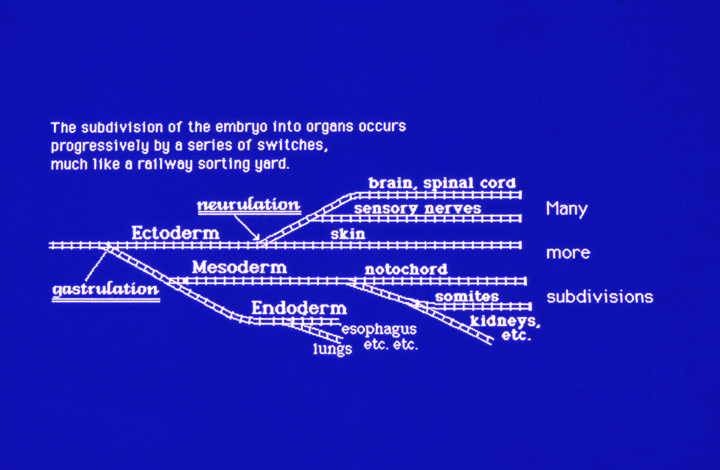Lecture notes for Monday, January 13, 2014
Video of neural tube folding
Some things we can start by simple memorization, and then gradually explain the underlying causes (when these are known, which sometimes has not been accomplished)


Please memorize the following:
Ectoderm becomes Nerves and outer layer of skin.
Also some other things: teeth, the eyes, sensory part of the nose and ears
Also one layer of the amnion and one layer of the chorion, both of which are extraembryonic membranes (think: placenta)
Endoderm becomes Lining of digestive tract; plus liver, pancreas, lungs, salivary glands
(all of which are out-foldings of the inner wall of the digestive tract.)
Two other extra-embryonic membranes are part endoderm:
The allantois and the yolk sac.
Mesoderm becomes Notochord, skeleton, muscles, inner layer of the skin, (leather)
kidneys (and human embryos form 3 pairs of kidneys)
Heart, blood vessels
Coelomic cavity, and layers of all 4 extra-embryonic membranes.



Primordial Germ Cells become oocytes and sperm.
Please note that primordial germ cells are not considered to belong to any of the three primary germ layers.
In mammals, the primordial germ cells start in part of the yolk sac.
In birds, the primordial germ cells start in a crescent-shaped area in front of the head.
In frogs, the primordial germ cells start in part of the endoderm.
In flies and nematodes, the primordial germ cells start at the most posterior extreme end of the embryo.
If you cut out the source of these primordial germ cells, then the animal will be sterile. If you graft primordial germ cells to another animal of the same species, then the eggs or sperm they produce will include some that are genetically identical to the animals from which you grafted the tissue. This is not true if grafts are made from any other part of the animal.
Early embryos of flies and nematodes have special cytoplasmic granules in the part of the embryo from which the primordial germ cells are going to develop. If you surgically move these granules to other locations, then the tissues at those places will become primordial germ cells. Guess what happens if you remove all those granules. Then explain to me what sense this all makes, because I don't understand.
I don't know where primordial germ cells develop from in echinoderms, mollusks, or cniderians. Probably some "boon-dock" part of the early embryo. The most plausible explanation that I have ever heard for doing things this way is that it serves to protect the future sperm and egg cells from cell-to-cell signaling mechanisms that otherwise would "turn off" or "turn on" gene transcription, in the sense that the primordial germ cells might accidentally get turned into live cells or muscle cells or something
Another possibility is that this set of phenomena might avoid genetic aging.
Scott Gilbert calls this "The Inert Genome Hypothesis" on page 597 of the textbook. He also mentions evidence that certain transcription factors have higher concentrations in the parts of fly and nematode cytoplasm that become primordial germ cells.
It seems to me that a good experimental test of this Inert Germ Hypothesis would be to cut the future primordial germ cell tissue out of very early bird, mammal or frog embryos, and graft it to various central locations of the embryo, such as where gastrulation or neurulation is occurring. To the extent that this hypothesis is correct, then egg cells and sperm cells would either produce nerve-specific or muscle-specific proteins, not normally synthesized by gametes and/or embryos that develop from these eggs and sperm would be anticipated to have over-developed nervous systems, or over-developed mesoderm. Or maybe certain categories of tissue would be under-developed. Abnormalities of these kinds ought to occur if the genome isn't inert, in the sense of this hypothesis.
I have never heard, even as a rumor, that anybody has tried this kind of experiment. It would be difficult, and the predicted results not very precise, which would tend to prevent such experiments being funded by granting agencies, which prefer "sure things", especially when all medical research is being cut back so much by "the sequester".